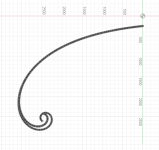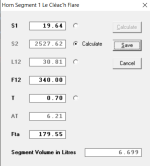Well that has to do with system integration and room interactions. Btw I now changed the crossover point to a lower value. And I like beamy speakers, assumingly. It is a compromise of course, you get more of a studio monitor-like presentation, a headphone experience without having the sound in your head. But mind you they are not that beamy, such that you need a vise to keep your head centered, but obviously the center place is the best. Like a F1 car. There is some wiggleroom in case you need to reach the bag of chips 😏What I will never understand is the use of a strongly beaming horn in order to get to 300 Hz and then crossing the driver over at 500 Hz with a 24dB/oct filter.
I do but scattered around in different files. I'll see if I can share them.Do you still have the coordinates of the profile, BTW? I would love to try it.
That wouldn't be the main problem with beaming sources (I don't move a lot during listening either). The bigger problem is that with a beaming source the early reflections contain only very little high-frequency energy. Don't ask me why but this just doesn't sound as natural as when these reflections are spectrally more similar to the direct sound. There's nothing you can do about this in the room - to regain balance you would have to absorb lower frequencies but not the higher ones - a tough task to do.But mind you they are not that beamy, such that you need a vise to keep your head centered, but obviously the center place is the best.
That would be great!I do but scattered around in different files. I'll see if I can share them.
Last edited:
In general you are right, but I addressed these problems with room treatment. Yes it was tough but worth it i.m.o. Diffusers combined with absorbers at the right places are your friend here.The bigger problem is that with a beaming source the early reflections contain only very little high-frequency energy. Don't ask me why but this just doesn't sound as natural as when these reflections are spectrally more similar to the direct sound. There's nothing you can do about this in the room - to regain balance you would have to absorb lower frequencies but not the higher ones - a tough task to do.
The only practical way to overcome the lack of radiated HF energy is to sit in so strong direct field that the reflections will add only marginally, and then the directivity of the source is of course much less important (to irrelevant). If you like that kind of headphone sound, good for you. Otherwise it would be a lot more difficult 🙂
Yes that is what I like and the people that visit, like it too. But you don't have the headphone effect, it still presents like a stereo system, with the "podium" in front of you. But details get trough convincingly. But every choice is a compromise in the end 😈If you like that kind of headphone sound, good for you.
Are you interested specifically in the petal version? There are, as you certainly know, other non symmetrical versions which deal with H. dispersion. If you want to try them out I could help with the profiles.
I'm interested in an axisymmetric one. I can always try a petal version based on that, but I'd like to see the performance of a "pure" one.
Thank you for the offer, very nice! The absence of first reflections does not bother me. Well, I did use a biradial tractrix horn before, but in the end I ditched it because of the pattern flip, the round/petal horn I now listen to sounds more natural to me. I am able to create horn profiles myself -but again thanks for your involvement.If you want to try them out I could help with then profiles.
What cut off frequency, T, throat diameter and exit angle of compression diver?I'm interested in an axisymmetric one.
Working on a second pair of Le'Cleach horns. Unfortunately I need to replace the nozzles of my printer as they have worn out after several km's of filament 🙁 Still 11 parts to go...

Hornresp gives an exact solution which is slightly different in the mouth when compared with the older spreadsheets , the "canonical" use for a horn like this has been T=0.7 and using it above around 2x cut off. I attach a comparison between the spreadsheet and Hornresp (units not correct) for a 340Hz/T=0.7 horn with a 2 inch mouth and the exported horn geometry profile from Hornresp.
Attachments
Last edited:
I used the spreadsheet from Le'Cleach, looks slightly different indeed. If it matters, don't know.Hornresp gives an exact solution which is slightly different in the mouth when compared with the older spreadsheets
Thanks! I quickly put it into Ath&ABEC. Overall, no surprises -


I like the impedance, hate the beaming.
(It could probably be approximated by a R-OSSE profile quite well, I may try that some day. I'm sure several very similar horns have been shown in this thread already - perhaps something like this: https://www.diyaudio.com/community/...-design-the-easy-way-ath4.338806/post-7337185, which probably wouldn't suffer as much from the "group delay issues" around cut-off, so often mentioned.)
I like the impedance, hate the beaming.
(It could probably be approximated by a R-OSSE profile quite well, I may try that some day. I'm sure several very similar horns have been shown in this thread already - perhaps something like this: https://www.diyaudio.com/community/...-design-the-easy-way-ath4.338806/post-7337185, which probably wouldn't suffer as much from the "group delay issues" around cut-off, so often mentioned.)
Last edited:
BTW, this is the whole effect of the full rollover -






(I'm only not sure about the irregularities above 7 kHz, can't get rid of them, may be numerical - probably better ignored for now.)
(I'm only not sure about the irregularities above 7 kHz, can't get rid of them, may be numerical - probably better ignored for now.)
Freestanding 46 degree B&C DE111 R-OSSE over an 8 inch Dayton DC200-8 in a 9x9 inch enclosure. Waveguide can be moved up and down to find the best center-to-center distance relative to crossover.
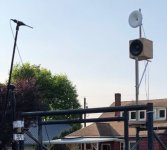
I don't know how to make crossovers. I'm learning in VituixCAD. I create the crossover then export it to Equalizer APO. That allows me to hear the crossover changes immediately. I'm listening to high order crossovers to get a feel for it then I'll back off to lower order crossovers more suitable for passive designs.
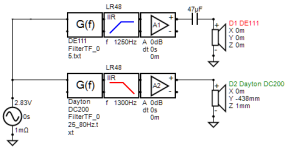
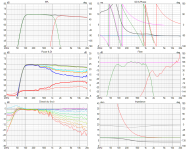
As expected, waveguide performance matches the simulations.
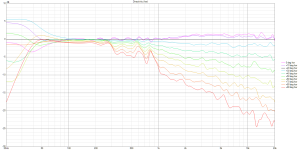
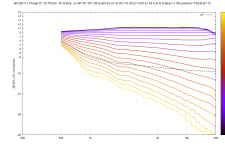
I've listened to stereo music and watched a movie using only one speaker as a center channel. Music is very good but I'm most impressed with how well it works as a center channel for dialog intelligibility.

I don't know how to make crossovers. I'm learning in VituixCAD. I create the crossover then export it to Equalizer APO. That allows me to hear the crossover changes immediately. I'm listening to high order crossovers to get a feel for it then I'll back off to lower order crossovers more suitable for passive designs.


As expected, waveguide performance matches the simulations.


I've listened to stereo music and watched a movie using only one speaker as a center channel. Music is very good but I'm most impressed with how well it works as a center channel for dialog intelligibility.
Crossover is anything that leads to a desired acoustic result without burning anything 🙂I don't know how to make crossovers. [...]
It's amazing to see it working so nicely. Now give yourself time to listen and adjust - you can still make it anything from great to unlistenable just by small tweaks in the crossover.
It just calls desperately for a cardioid (semi-open back) midrange. With that the DI transition from low to high would be a lot smoother, basically eliminating any significant rise in the whole range above the modal region of a room.
Last edited:
- Home
- Loudspeakers
- Multi-Way
- Acoustic Horn Design – The Easy Way (Ath4)
